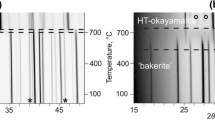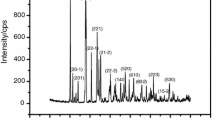Abstract
Thermodynamic properties of high-pressure minerals that are not recoverable from synthesis experiments by conventional quenching methods (“unquenchable” phases) usually are calculated from equation of state data and phase diagram topologies. The present study shows that, with cryogenic methods of recovery and sample treatment, phases with a suitable decomposition rate can be made accessible to direct thermodynamic measurements. A set of samples of Ca(OH)2-II has been synthesized in a multianvil device and subsequently recovered by cooling the high-pressure assembly with liquid nitrogen. Upon heating from liquid nitrogen to room temperature, the material transformed back to Ca(OH)2-I. The heat effect of this backtransformation was measured by differential scanning calorimetry. A commercial differential scanning calorimeter (Netzsch DSC 404), modified to allow sample loading at liquid nitrogen temperature was used to heat the material from −150 to +200 °C at rates varying between 5 and 15 °C min−1. The transformation started around −50 °C very gradually, and peaked at about 0 °C. To obtain a baseline correction, each sample was scanned under exactly the same conditions after the backtransformation was complete. Because of the relative sluggishness, onset and offset temperatures were not well defined as compared to fast (e.g., melting) reactions. To aid in integration, the resulting signals were successfully fitted using a generic asymmetric peak model. The enthalpy of backtransformation was determined to be ΔH =−10.37 ± 0.50 kJ mol−1. From previous in situ X-ray diffraction experiments, the location of the direct transformation in P-T space has been constrained to 5.7 ± 0.4 GPa at 500 °C (Kunz et al. 1996). With the reaction volume known from the same study, and assuming that ΔC p of the transformation remains negligible between the conditions of our measurements and 500 °C, our result gives an estimate of the entropy of transition and the P-T slope of the reaction curve. To a first approximation, the values ΔS = −16.00 ± 0.65 J(mol · K)−1 and dP/dT = 0.0040 ± 0.0002 GPa/K have been determined. These results need to be refined by equation of state data for Ca(OH)2-II.
Similar content being viewed by others
Author information
Authors and Affiliations
Additional information
Received: 30 December 1999 / Accepted: 10 April 2000
Rights and permissions
About this article
Cite this article
Schoenitz, M., Navrotsky, A. & Leinenweber, K. The enthalpy of transformation of Ca(OH)2-I (portlandite) to Ca(OH)2-II (EuI2 structure) by low-temperature DSC. Phys Chem Min 27, 604–609 (2000). https://doi.org/10.1007/s002690000104
Issue Date:
DOI: https://doi.org/10.1007/s002690000104




